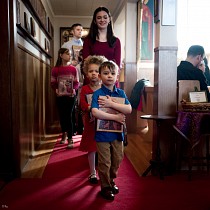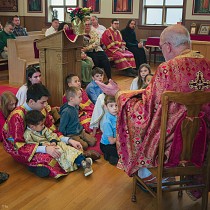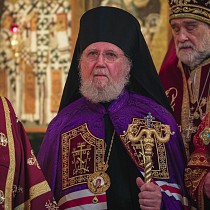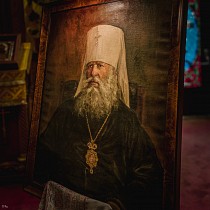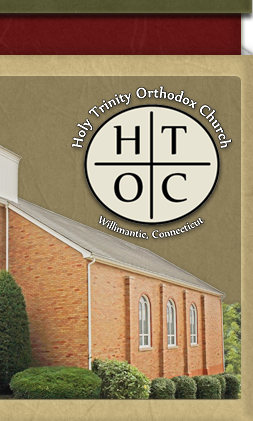Prosphora Baker: Mrs. Merci Matcheson
The Holy Mystery of Communion, or the Eucharist, is embodied in the wine and leavened bread that are offered as the "gifts" (or body and blood of our Savior, Jesus Christ) in the Divine Liturgy. "Prosphora" comes from the Greek word meaning "that which is offered". The method of making prosphora is an ancient one, and is always accompanied with prayer and humility.
In the Slavic tradition, smaller commemorative prosphora have important significance during the Divine Liturgy. Many of the faithful who gather that day will offer a small commemorative prosphora and submit a list of names to the altar, both living and deceased, whom they would like to have remembered in prayer during the Proskomedia ("Liturgy of Preparation").
As the priest reads the individual names of each person aloud, he removes a small particle from their commemorative prosphora which is then placed on the Diskos beside the larger particle which has been removed from the prosphora for both the living and those fallen asleep in the Lord. The names of those individuals prayed for rest alongside the Lamb of God, the mother of God and the nine ranks of saints.
After the Holy Eucharist has been distributed, the presbyter places the remaining particles from the Diskos, each representing a specific person known by God, and puts them into the Chalice with these words: "Wash away, O Lord, the sins of all those remembered here, by Thy precious Blood, and through the prayers of all the saints."
After Divine Liturgy, the now blessed commemorative prosphoras are returned to the faithful who had submitted the prayer requests. They are often taken home and reverently consumed, and also shared with family memebers and friends.
Prosphora is a Greek word meaning "offering." Historically, the bread was not only a gift for use in the Divine Liturgy, but it was also a gift to feed the poor.
Prosphora is made of just four ingredients:
- Unbleached flour
- Yeast
- Water
- Salt
The Slavic tradition uses a small seal, stamped on five loaves, to signify our Lord's "Feeding of the Five Thousand." These small loaves are made with two layers to represent both the two-fold nature of Christ (Human and Divine), and the uniting of heaven and earth. The Greek style, which uses one large loaf marked with ICXC - NIKA in the center, surrounded by several other seals, signifies the one Body of Christ.
Before you begin:
O Lord Jesus Christ, only-begotten Son of the Eternal Father, who has said with your most pure lips: without me you can do nothing. O Lord, my Lord, with faith I accept your words, help me a sinner to prepare the bread of offering, that the works of my hands may be acceptable at your holy table, and may become through the operation of your Holy Spirit, the communion of “your most pure Body for me and all of your people.”
In the name of the Father, and the Son and the Holy Spirit, Amen.
After you finish:
O Lord and Master Jesus Christ, our God, who alone has power to forgive the sins of mankind, do you O Good One, who loves mankind, forgive all the sins that I have committed in knowledge or in ignorance, and make me worthy to receive without condemnation, your divine, immaculate and life-giving mysteries; not unto punishment or unto increase of sin, but unto purification and sanctification and a promise of your kingdom and the bread of life; as a protection and a help against all adversaries. For you are a God of mercy and compassion and love toward mankind, and unto you we send up glory together with the Father and the Holy Spirit, now and ever and unto ages of ages. Amen.
For a 7” round baking pan at least 3” high
Ingredients:
- 5 cups unbleached bread flour
- 3 tsps. Saf-Instant Yeast
- ¾ tsp. salt
- About 2 cups of very hot tap water
Sift dry ingredients into a large mixing bowl. Blend with a dough hook on low. Gradually add enough hot tap water to make a soft dough that doesn’t stick to the side of the bowl. Remove the dough from the bowl and knead by hand until the dough is firm – 5 to 8 minutes.
Put the dough in a large bowl lightly sprayed with cooking spray. Cover the bowl with a damp towel and move to a warm place and let it double in size – approx. 45 minutes. Punch down the dough. Divide the dough into 2 pieces, one being slightly larger than the other. With your hands, roll the larger piece until smooth and then flatten to fit in the bottom of a sprayed 7” round baking pan, smooth side down.
Roll the smaller piece into a smooth, tight ball. Slightly flatten the ball to be smaller than your 6” seal. Press the seal down hard on the dough and pull it straight up. Place this piece on top of the other piece in the pan. Place in a pre-heated 350° oven. Conclude with prayer.
Bake at 350° for 15 minutes and then lower the temperature to 325°, cover the bread completely with foil to prevent the top from browning. Continue baking for another 30 minutes. Remove the bread from the pan and cover with a damp towel and let cool on a rack. Remove the towel after 5-10 minutes.
The sides of the bread should be lightly browned.
Contributed by Merci Matcheson
Click: Prosphora Recipe to download a copy
Prosphora is the bread of prayer. Prosphora is made with prayer, for prayer. Prosphora is one of the defining features of Orthodoxy and is unique to Orthodoxy.
Prosphora contains just four physical ingredients: water, salt, flour, and yeast, with the fifth ingredient being prayer. The word “Πρόσφορον” (prosphoron), means offering, since we offer it with prayers to the Church, and the Church offers it with prayers to God. The word “Ἀντίδωρον” (an-TI-do-ron), also refers to prosphora, meaning “instead of the gifts.” Prosphora is offered for the Eucharist and the remainder is given back as antidoron after Holy Communion and distributed to those who did not commune.
Prior to the Liturgy, usually during the Third and Sixth Hours, Orthodox clergy perform the Proskomedia (oblation). In the Slavic tradition, five loaves of used
Loaf #1
With prayers calling to remembrance the events at Golgotha, the priest cuts the Lamb from the first loaf. Then the priest pierces the prosphora to commemorate Christ being piered with a spear by one of the soldiers. Like blood and water which flowed from our Lord’s side, when the Lamb is pierced, the priest adds water and wine to the chalice.
Loaf #2
From the second prosphora, a rectangular piece is removed to commemorate the Theotokos, the Mother of God, and it is placed to the right side of the Lamb from the first loaf.
Loaf #3
Nine pieces for the nine ranks of saints follow. They include commemorations for:
1) Angelic powers
2) Forerunner (John the Baptizer) and prophets
3) Saints Peter & Paul and all the Holy Apostles
4) Holy hierarchs
5) Martyrs
6) Holy & venerable fathers and mothers of the church
7) Unmercenaries and wonderworkers
8) The Ancestors of God (Joachim & Anna) and saints of the day
9) Liturgist of the day, usually St. John Chrysostom (Basil the Great during Lent, and other selected days).
Loaf #4
The ruling bishop is then commemorated, along with all civil authorities (in general, as non-Orthodox cannot be commemorated with the Eucharist), then all the faithful, both living and departed, whose names have been entered for commemoration, cutting a particle for each and putting it on the paten.
Loaf #5
After the living, the pious rulers, church founders, and the priest’s ordaining bishop are commemorated, with their own particles. Finally, the priest cuts a particle for himself, covers the gifts, and censes the entire church while reciting Psalm 50. The particles remain on the paten throughout the Liturgy and become the Body of Christ.
This rite is so powerful that the new St. Paisios walked into the altar during Proskomedia, saw fire over the table, and was never ordained.
Antidoron is a universal way of taking the Divine Liturgy home. It is church practice to bring a commemorative loaf of prosphora home and to eat a piece upon awakening. This gives us a tangible tie in with our prayer life. Most importantly, any Orthodox can be commemorated at the proskomedia, even if they are unable to come to church. Space is no obstacle, death is no obstacle, and even sin is no obstacle. Only heresy and schism are obstacles, because they affect our connection to Christ. This emphasizes cosmic nature of the liturgy.
- John Lardas, University of Connecticut (Class of 2017)
Click: Prosphora is the Bread of Prayer to download a copy
|
|
|








